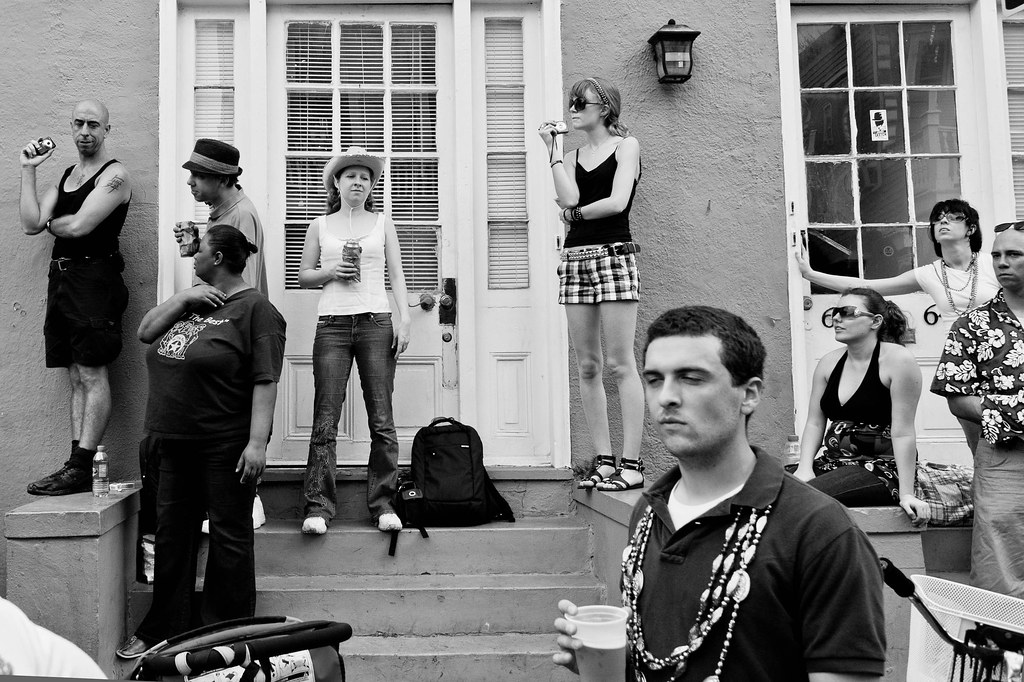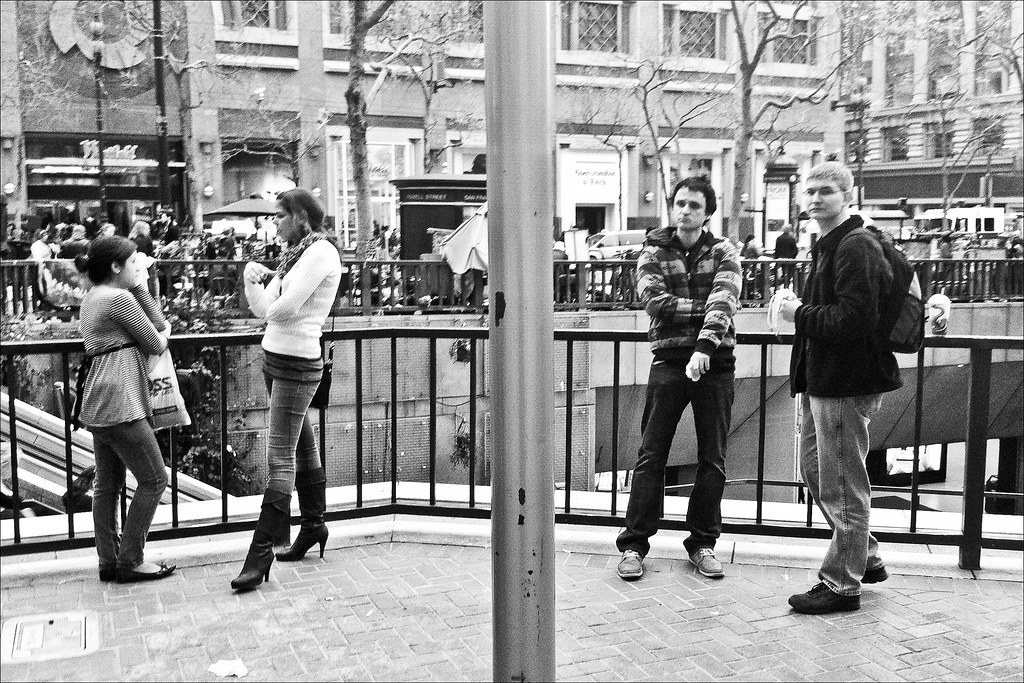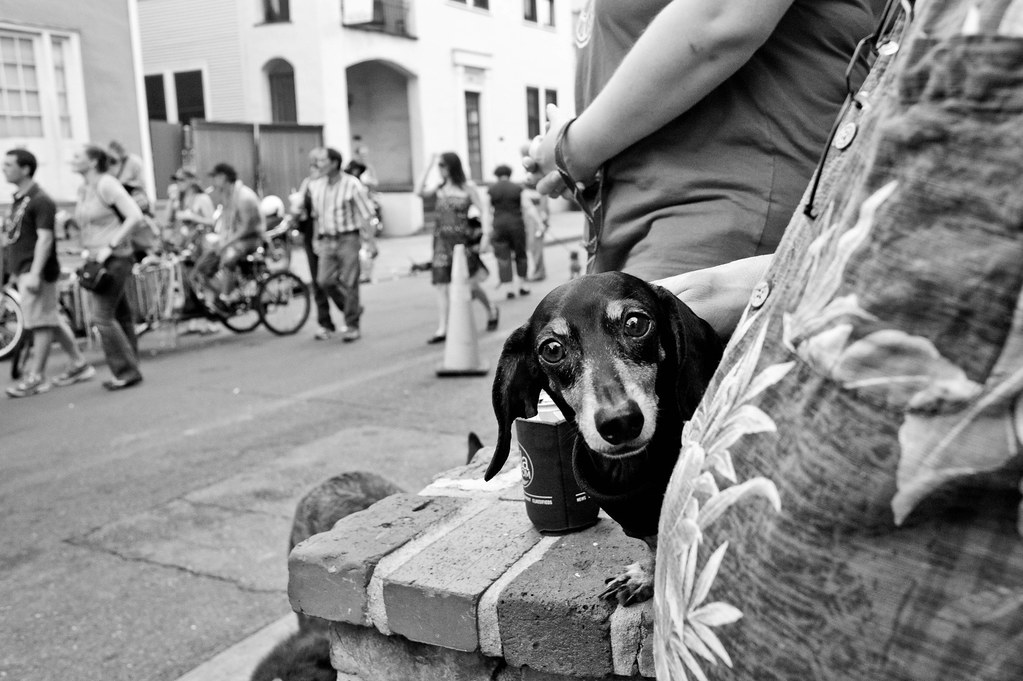Monday, March 28, 2011
Monday, March 21, 2011
Masks
Shot this when I was in New Orleans a few weekends back. Most of the people on Mardi Gras floats wears masks. Growing up, I never thought much of it -- other than "Hey, cool costumes". Coming back to it after some years, they actually kind of seem pretty creepy and maybe evocative of some unpleasant eras in the past of the South.
Which reminds me -- an old friend of mine's sister actually made a documentary about Mardi Gras in my home town called "The Order of Myths". Mardi Gras is this intricate social ritual in some Southern towns that was completely lost on me as a fairly nerdy kid from a not-so-well-connected family growing up.
Friday, March 11, 2011
Bystanders
Mardi Gras parades are definitely about pageantry, but the crowd is definitely something that's on display too. This was shot in the French Quarter, and most of the people were trying to peer over or around the crowd to get a glance of Barkus as it passed.
*
Off-topic for this post (but on-topic for the blog), check out this link:
http://www.formatfestival.com/artists/garry-winogrand
This is a rare color exhibition of Garry Winogrand's work, curated by Joel Meyerowitz (who shot with Winogrand). Every one of these images is striking (I would even say magnificent), and each of them has the property that if you had dropped them in my lap, I would have guessed they were Winogrands. They are utterly distinctive to him, and kind of a photo acid trip any time I see his color work.
Wednesday, March 9, 2011
Division
Was tooling around with my iPhone last Saturday, and I shot this, which is fun. Like the Polaroid, the iPhone is limited in a lot of ways, but unlike the Polaroid, I find I'm capable of making images with it that I'm really happy with. My operating theory is that the iPhone is like having a ginormous viewfinder, which really helps me with composition.
Tuesday, March 8, 2011
Barkus
There are a lot of parades in New Orleans in the weeks leading up to Mardi Gras. Some of them (particularly the parades of the weekend before and actual days of) Mardi Gras are huge, while others are merely big. Despite what you may hear, they don't let any of the big ones into the French Quarter these days -- too many people, and too much of a hazard. There are a number of small parades though, including this one, which is whimsically entitled "Barkus". It's dog-themed, and lots of people go take their dogs and their music and walk it through through the high points of the quarter.
Snapped this as we were actually trying to get *away* from Barkus, which was so crowded you could barely see the dogs.
Her First Beads
Shot this one on a trip to New Orleans last weekend. B didn't see the point of why people were going so nuts for Mardi Gras beads at first, but once I caught a set and gave them to her, she got right into the mania.
On thing about photos of B -- they're always best in wild color (how can you not, with her hair?), and shot fast. You don't catch a grin like that tromping around in the basement of 1/250ths of a second. 1/500 or go home. ;)
Monday, March 7, 2011
Rancid
The first camera I ever owned as a kid was a Polaroid. Unfortunately, I got my camera just as the tough times of the early 80s hit, so I basically got the camera only to not have any film for it.
Flash-forward to this Christmas, when I found my nearly thirty year old camera in a closet at my parent's house in Alabama. By a fortunate series of events, it had survived two floods, Katrina, my mother's love of yard sales, and general entropy to be right there on the top of a stack of boxes when I opened the closet. The only hitch: They don't make Polaroid any more. And what (expired) Polaroid film there is left will cost you an arm and a leg on eBay.
I'd heard about this company called "The Impossible Project", who were trying to bring back Polaroid. They'd bought an old Polaroid factory, and were now rolling out their own film -- pretty awesome hack!
So, I ordered three packs of the stuff and went crazy with my Polaroid.
I have to say, it's kind of a miracle that the IP people have replicated something close to Polaroid -- but more often than not, I felt like it was a miracle that it worked at all. :P
Here were the challenges:
- Your Polaroid 600 never tells you what the results of metering are. You have a slider to adjust the metering, but this always feels a bit like the blind leading the blind. ;)
- The Impossible Project film is extremely light sensitive as it develops. Even though it has a chemical on it to shield it from light once it leaves the camera, if you don't physically shield it from light in the first minute, it loses contrast big time.
- Make sure it stays horizontal so the developing goo is evenly applied
- Make sure the temperature is 'right' in that first minute. Too cold, and you lose contrast. Too warm, it turns too toasty amber (not a fan of deep sepia). Just right (maybe room temperature?), it's closer to b&w.
- Fitfully check development, only to learn that the rollers on your 30 years old camera managed to poorly distribute the goo over the film, and half of it is overexposed.
- Fitfully check for factory defects in the film, where regions of the film don't have developing chemicals at all
- Worry at night how long the print will last if it's not stored in some lead-lined box away from all high energy particles which threatens to dissolve the glue from the back.
- Worry you may have to sell more shares of stock to pay for more exposures (~$2 a shot!)
Given the sort of high maintenance nature of the IP film, I ended up mainly using it for portraits of my friends. This is the only one from the street that I got that I found remotely passable.
I saw this kid sitting on the steps by Union Square, and he just had the perfect expression, and was just in the right light. I asked to take his portrait, he was happy to (and in fact, didn't even change his expression much).
The result was...
a perfectly white image, because my camera failed to roll goo over the film properly.
The kid was pretty zen about the whole thing, and I happily gave him the missed exposure as a keepsake. What you see above is my second shot.
I have to say, I "get" that it's fun to have this random element in your exposures, because it can force you to see new things in an image. But it feels like there's a line where it stops being random, and it starts being irritating. :P
Basically every photo I took with the IP film had that error at the top, where there just wasn't any developing chemical. Once, it's a beauty mark. Twice, it's a blemish. The whole pack? It's the plague.
Still, there's something to the idea that I got a physical artifact out of the whole deal, and I do love the character in the piece. But life seems a little short to deal with all the problems this film has -- maybe not for me. I think if I'm going to shoot film, it'll be something where I have just a bit more consistency and control. :\
For another take on this image, you should check out my friend Damien's take. He went ultra-wide, and at a very distinct angle -- fun contrast to my polaroid work.
Subscribe to:
Posts (Atom)






